You’ll find the bulletin for this service at FCC’s Facebook page, here.
Featured Image Credit: public domain image from Pexels.
You’ll find the bulletin for this service at FCC’s Facebook page, here.
Featured Image Credit: public domain image from Pexels.
Featured Image Credit: Winter Sunrise, Public Domain Image courtesy of Pixabay.
On the fifth Sunday after Epiphany (February 4, 2018), the Rev. Dr. Arthur Suggs continued with — as he said — “a series of sermons on primal archetypes that wind their way through the scriptures, bend their way through the world’s religions, and churn their way through our lives. First in the series was trees, the second was mountains, the third was light, today is music, and next will be water.”
Spiritual Music … the Beatles?
The Rev. Dr. Suggs started with this: “For the sermon this morning, let me begin with part of an article from about a year ago. It was strange because only after reading the article did I look at who wrote it and realized that I know him:
“As a child being raised in a troubled home, religion and spirituality were discussed about as often as we discussed opera, which was never. Music and, to a lesser degree, nature were my sole companions. Turning on the radio one day, I heard a hit song that began, ‘Help! I need somebody! Not just anybody! Help! You know I need someone! Help!’
“I was a twelve-year-old boy, and, like John Lennon, I also needed help, but I didn’t know where to turn. I did not have a girlfriend, therapist, church, or relationship with a ‘concept’ called God. So I turned to the Beatles, none of whom professed or practiced Christianity, and yet they wrote and recorded song after song that came from a place of deep spirituality.”
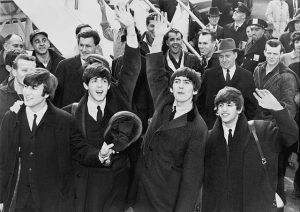
“It was not Jesus, Yahweh, Sigmund Freud, Higher Power, or Jehovah that led me to hope for some ‘Help!’ It was the Beatles. George Harrison was a Hare Krishna who wrote ‘My Sweet Lord’ and ‘Give Me Love’; John Lennon penned ‘Eleanor Rig-by,’ ‘Imagine,’ and ‘Give Peace a Chance’; and Paul McCartney composed ‘Lady Madonna,’ ‘Black Bird,’ ‘Let It Be,’ and ‘Hey Jude.’”
A Powerful Link Between
Music and Our Deepest Emotions, from Sadness to Joy
“There’s a link, somehow or other, between all kinds of people and their varieties of music. Many researchers have studied this phenomenon, and there’s a very powerful link between music and our deepest feelings, our deepest emotions, covering the range of emotions from sadness to joy and everything in between.”
Rev. Suggs shares examples of evocative music, from the recognizable scores of The Titanic and Schindler’s List films, including the “Hymn of the Sea” in the former and Itzhak Perlman’s violin solo in the latter – “a very simple violin piece that makes you ache inside with both sadness and beauty.”
Then a song from the Rocky III soundtrack …
“So I’m tooling down Route 17 when “Eye of the Tiger” comes on, and I crank it up loud. In my mind, I’m Rocky, defeating the enemies, unbeatable, and listening to this music.”
“Suddenly, I look down, and I’m going 95 miles an hour. A wave of panic comes over me, and I check all the mirrors, not expecting to see one cop but anticipating six cops behind me. Thankfully, there’s no cruiser, but I slow way down to a normal speed limit. How do you get so engrossed that you don’t even know you’re going 95 miles an hour? It’s amazing.”
Jimmy Hendrix, Woodstock, the “Flower Duet” from Delibes’ opera Lakmé, Eminem, Amazing Grace, praise bands, Gregorian or Taizé chant … and then some.
Rev. Suggs continued …
Everything in the Universe Vibrates in Motion with Frequency and Sound
Plato wrote: Music “gives soul to the universe, wings to the mind, flight to the imagination, and charm and gaity to life.”
I suggest to you that it’s sort of significant for Plato to say that. Here’s the author who introduced into the world the idea of the soulness of things. “Music gives soul to the universe.”
Two observations:
There does not exist a religious tradition that does not have music integral in some way. Even the traditions based on silence (Quakers, Zen Bhuddism), chant music of some type as prelude and postlude for them. It’s found everywhere.
The other observation is one that I think we do take for granted, but it’s only things that are categorically true. There are zero exceptions to this and that is:
Everything in our universe vibrates. Every single portion of our universe is in motion with a frequency and a sound and a vibration.
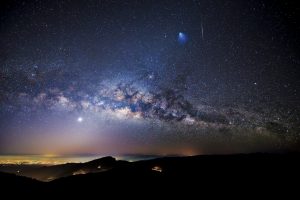
EVERYTHING!
Our Milky Way goes around once every 230 million years. The Sun and our whole solar system orbit the Milky Way in 230 million years.
Our Earth circles the Sun, and we define it as a year.
Our moon circuits the Earth every 28 days.
We observe the sabbath based upon our religious traditions every seventh day.
The cycle of our day is based upon the rotation of the Earth relative to the Sun.
And so we have breakfast, lunch, and dinner every day.
We have waking and sleeping every day, and work and leisure every day.
Our hearts beat around 70 times per minute.
Our respiration is about 20 times per minute.
We can hear music from 60 hertz up to the vicinity of 20,000 hertz.
The vibration of atoms in general is 1013 hertz.
Every ray of light has a frequency to it.
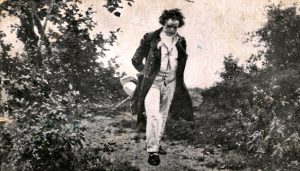
Ludwig van Beethoven said:
“Music is the mediator between the spiritual and the sensual life.
So what we do, with a combination of both art and science, is that we organize the frequencies. We manipulate and arrange the vibrations to express our grief and our joy, our sadness and our exultation, our longing and our reverence.”
Amen.
Featured Image Credit: Flash Mob! HKFO performs the Beethoven “Ode to Joy” Flash Mob, Hong Kong’s largest choral-orchestral flash mob at Shatin New Town Plaza on 28 July 2013.
On the fourth Sunday after Epiphany (January 28, 2018), in a series of sermons on the great archetypes in the bible, the Rev. Dr. Arthur Suggs reflected, and spoke, on the universal, multi-tradition symbolism of Light and the power to overcome those deep valleys of unknowing, uncertainty, fear, and even despair.
Others in the Great Archetypes series include Trees, Mountains, Music, and Water. (You’ll see those in the Recent Posts at the sidebar if they’ve been uploaded to date.)
Rev. Suggs began the sermon on the archetype of Light with the following:
“Far, we’ve been traveling far without a home, but not without a star.” ~ Neil Diamond, America
“But soft, what light through yonder window breaks? It is the east, and Juliet is the sun.” ~ William Shakespeare, Romeo and Juliet
“Look to my coming, at first light, on the fifth day. At dawn look to the East.” ~ J.R.R. Tolkien, Gandalf in Lord of the Rings
He says, “You are the moon of my life.” And she replies, “My sun and my stars.” ~ George R.R. Martin, Game of Thrones, Khal Drogo to his Khaleesi
… Is a powerful metaphor and a dynamic symbol in all parts of our culture.

In paintings of every type, the artist plays an unusual dual role by painting light itself as an important motif in the picture and then by lighting the whole picture.
In stage and theater, the art of lighting can spell the pinnacle of performance or the death of dreams.
Throughout literature, authors depend on light to excite their insight. I have provided a few examples from various media.
Light permeates all of theological printing and speaking, and it is found virtually everywhere in the sciences.
Even a musical concert can be enhanced or ruined by the lighting. The solo spotlight on a piano performance. Or the lasers and the burst of flame at a rock concert. Or — and you’ll find this hard to believe — spotlights on preachers.
Light has pervaded our language:

“There’s light at the end of the tunnel,” an expression that we use when we’ve been trudging through something, and “Finally there’s a measure of hope at the end.”
In American politics, pretty much every four years or so, we have “The dawning of a new era.” Reagan got a lot of mileage out of “Morning in America.”
Or we hire an expert to “Shed light on the subject,” whatever it might be.
The imagery infuses our soul as well:
Here are some samples from the Bible. These are among the few equations of God:
“God is light.” It doesn’t say, “God is the light.” It doesn’t say, “God is a light.” It just says, “God is light.” God equals light. There is only a handful of other equations like this: God is spirit, God is bread, God is love.” ~ The First Letter of John, Chapter 1, Verse 5
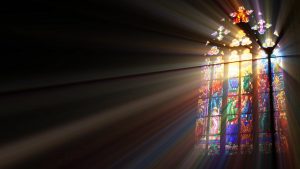
The Letter of Paul to the Philippians, Chapter 2, Verse 15, speaks to the children of God, this is for you: “Shining stars in the sky.”
“Let your light so shine before others.” Don’t put a bushel basket over it. Let it shine the way the song says. ~ The Gospel According to Matthew, Chapter 5, Verse 16The first Letter of
Or in Paul’s First Letter to the Thessalonions, Chapter 5, Verse 5: “You are children of the light, and children of the day.”
. . . many of the aspects of standard orthodox Christianity don’t suit me very well.
There’s an example with the notion that “God is light.” So it says in The First Letter of John, and then in the Gospel of John he adds two more verses to it.
Now I want to put the three of them together, and you tell me what you think it means:
As mentioned, in his First Epistle, John says, “God is light.” But then, in the Gospel According to John, Jesus is recounted as saying, “I am the light of the world.”
Now bear in mind that he spoke problematically in Aramaic, translated into Greek, and then translated into English.
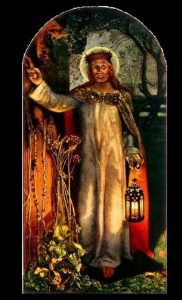
Fortunately, the linguistic construction is identical in all three languages. “I am” is both the belief of referring to “me” or it’s the name of God. Either he’s saying “I am the light of the world,” citing himself that he, Jesus, is the light of the world, or he might be saying, “God is the light of the world.”
To add to the confusion, a little later he says, “You are the light of the world.”
There’s a part of me that wants to take all this at face value and ask, “How are we to understand this?” And so I’ve got these three thoughts here — “God is light,” “I am the light of the world,” and “You are the light of the world.”
At face value, the only conclusion I can come to is that there is a linkage between our physical being — who we are as homo sapiens, as organisms — and divinity.
There’s a linkage, an identity linkage, that either we want to deny it or ignore it or just set it aside and never preach on it, but it’s there in the background.
We’ve been looking at deep archetypes that run through scripture, and this is the third in a series.
We looked at trees two weeks ago; we looked at mountains a week ago; the notion today is light; and next Sunday it’s music. I’d like to offer two lessons from this notion of light, pervading its way through the scriptures but beyond the scriptures, infusing their way into every facet of human existence.
Read the rest of this sermon:
Featured Image Credit: Beam of sun light inside the cavity of Rocca ill’Abissu at Fondachelli Fantina, Sicily. By Fediona; Creative Commons via Wikimedia.